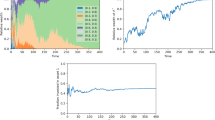Abstract
This paper uses ideas from biological evolution to analyze the evolution of the securities market in which rational and irrational traders coexist. A market evolutionary model is developed to describe the dynamic trajectories of rational and irrational traders’ wealth. The main question is, are irrational traders eliminated as the securities market evolves. The paper considers the impact of new entrants on the security market long-term equilibrium. In addition, it discusses the existence and uniqueness of the long-term equilibrium The paper finds that, under some market conditions, irrational traders could survive in the long run.
Similar content being viewed by others
References
Akbas F, Armstrong W J, Sorescu S, Subrahmanyam A (2015). Smart money, dumb money, and capital market anomalies. Journal of Finance Economics. 118(2): 355–382.
Alchian A A (1951). Uncertainty, evolution, and economic theory. The Journal of Political Economics. 58(3): 211–221.
Biais B, Shadur R (2000). Darwinian selection does not eliminate irrational traders. European Economic Review 44(3): 469–490.
Blume L, Easley D (1992). Evolution and market behavior. Journal of Economic Theory 58: 9–40.
Blume L, Easley D (2006). If you’re so smart, why aren’t you rich? Belief selection in complete and incomplete markets. Econometrica 74(4): 929–966.
Bottazzi G, Dindo P (2014). Evolution and market behavior with endogenous investment rules. Journal of Economic Dynamics and Control 48(11): 121–146.
Bottazzi G, Giachini D (2017). Wealth and price distribution by diffusive approximation in a repeated prediction market. Physica A: Statistical Mechanics and Its Applications 471: 473–479.
Bottazzi G, Dindo P, Giachini D (2017). Long-run heterogeneity in an exchange economy with fixed-mix traders. Economic Theory 66(2): 407–447.
Chiarella C, Dieci R, Gardini L(2006). Asset price and wealth dynamics in a financial market with heterogeneous agents. Journal of Economic Dynamics and Control 30(9-10): 1755–1786.
Evstigneev IV, Hens T, Schenk-Hoppe KR (2006). Evolutionary stable stock markets. Journal of Economic Theory 27(6): 449–468.
Fama EF (1965). The behavior of stock-market prices. Journal of Business 38(1): 34–105.
Fama EF (1970). Efficient capital markets: A review of theory and empiricalwork. Journal of Finance 25(3): 383–417.
Fama EF (1991). Efficient capital markets: II. Journal of Finance 36(11): 1575–1617.
Friedman M (1953). The case for flexible exchange rates. Essays in Positive Economics. University of Chicago Press, Chicago.
Grinblatt M, Titman S (1993). Performance measurement without benchmarks: An examination of mutual fund returns. The Journal of Business66.DOI:10.1086/296593
Guo J, He XD (2017). Equilibrium asset pricing with Epstein-Zin and loss-averse investors. Journal of Economic Dynamics and Control 76: 86–108.
Hirshleifer D, Subrahmanyamb A, Titman S (2005). Feedback and the success of irrational investors. Journal of Financial Economics 32(5): 1–28.
Higham DJ (2000). Mean-square and asymptotic stability of the stochastic theta method. Siam Journal on Numerical Analysis 38(3): 753–769.
Ikeda N, Watanabe S (1977). A comparison theorem for solutions of stochastic differential equations and its applications. Osaka Journal of Math 14(3): 619–633.
Kahneman D, Tversky A (1991). Loss aversion in riskless choice: A reference-dependent model. The Quarterly Journal of Economics 106(4): 1039–1061.
Lin L, Sornette D (2013). Diagnostics of rational expectation financial bubbles with stochastic mean-reverting termination times. European Journal of Finance 19(5): 344–365.
Lo AW (1999). The three P’s of total risk management. Financial Analysts Journal 55(1): 13–26.
Lo AW (2004). The adaptive market hypothesis: markets efficiency from an evolutionary perspective. Journal of Portfolio Management 31(1): 21–44.
Oksendal B (2003). Stochastic Differential Equations. Springer-Verlag, Berlin.
Sandroni A (2005). Market selection when markets are incomplete. Journal of Mathematical Economics 41: 91–104.
Seather BE, Engen SLR (2000). Estimating the time to extinction in an island population of song sparrows. Proceedings of Theory Society of London. Series B 267: 621–626.
Tversky A, Kahneman D (1979). Prospect theory: An analysis of decision under risk. Econometrica 47(2): 263–292.
Yan H (2008). Natural selection in financial markets: Does it work? Management Science 54: 1935–1950.
Yang Z, Qin G (2006). Continuous time evolutionary financial model and globally asymptotically evolutionary stable strategies. Economic Research Journal 5: 41–49.
Zhang YJ, Zhang W, Xiong X (2010). Strategies and investment returns: Agent based computational finance perspective. Journal of Management Science in China 13(9): 109–118.
Acknowledgments
We gratefully acknowledge editors of Journal of Systems Scienence and Systems Engineering, and two anonymous referees for their valuable comments and suggestions. This paper is supported by the National Natural Science Foundation of China under Grant No. 71790594 and Programfor interdisciplinary direction team in Zhongyuan University of Technology, China.
Author information
Authors and Affiliations
Corresponding author
Additional information
Pengju Zhao is an associate professor of Zhongyuan University of Technology, doctor degree ofNorthwestern Polytechnical University. Research direction: financial risk management, behavioral finance, fixed income bond.
Wei Zhang is a professor of Economics and Management School of Tianjin University, Doctor’s tutor, research direction: computational experimental finance, financial risk management, venture capital financing.
Yumin Liu is a professor of Business School of Zhengzhou University, Doctor’s tutor, research direction: quality management, statistical analysis.
Rights and permissions
About this article
Cite this article
Zhao, P., Zhang, W. & Liu, Y. The Evolution Dynamic and Long-Run Equilibrium in a Stock Market with Heterogeneous Traders. J. Syst. Sci. Syst. Eng. 29, 55–67 (2020). https://doi.org/10.1007/s11518-019-5426-8
Published:
Issue Date:
DOI: https://doi.org/10.1007/s11518-019-5426-8




